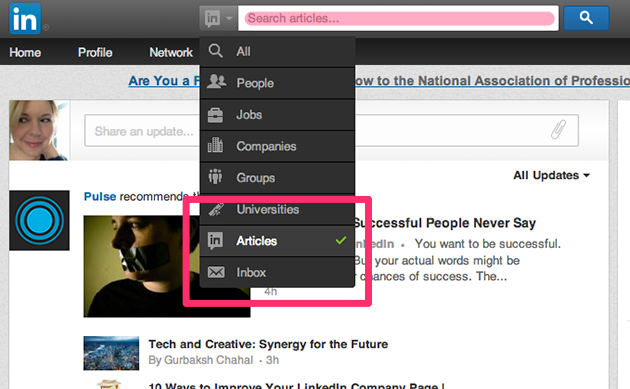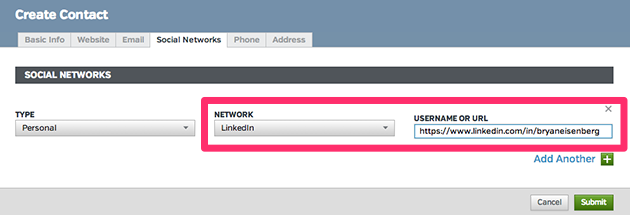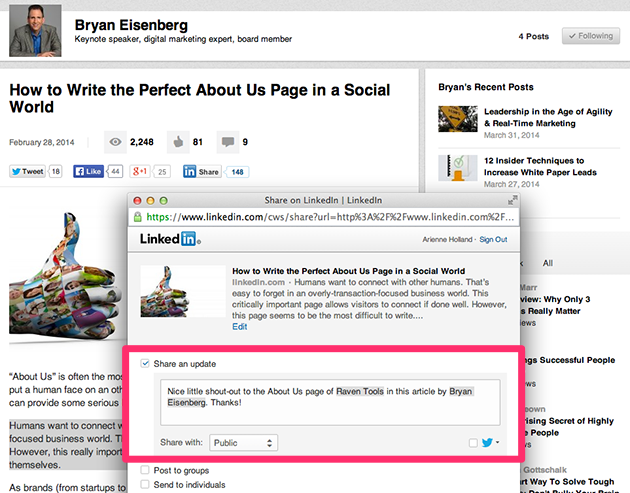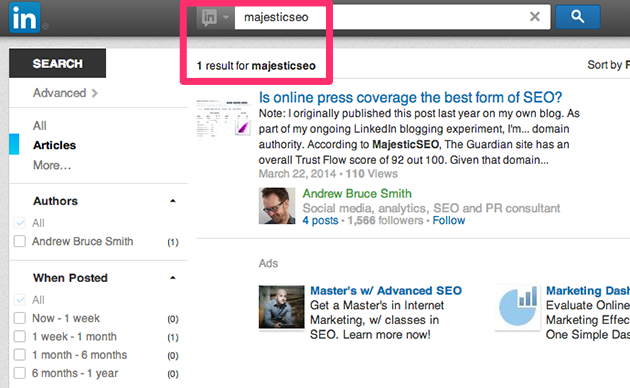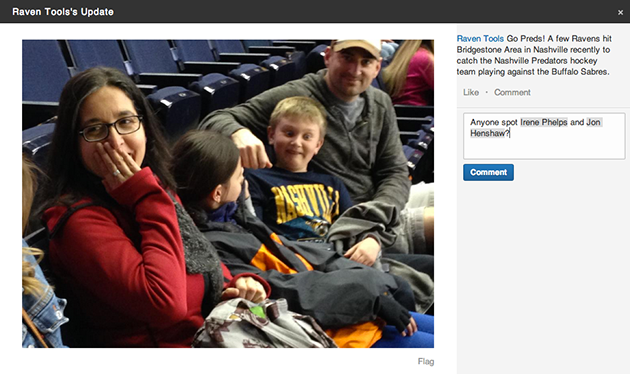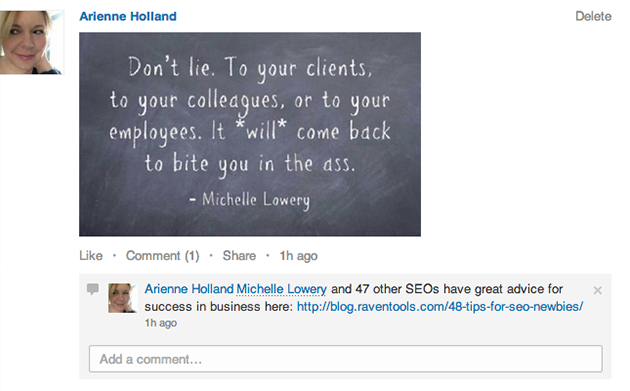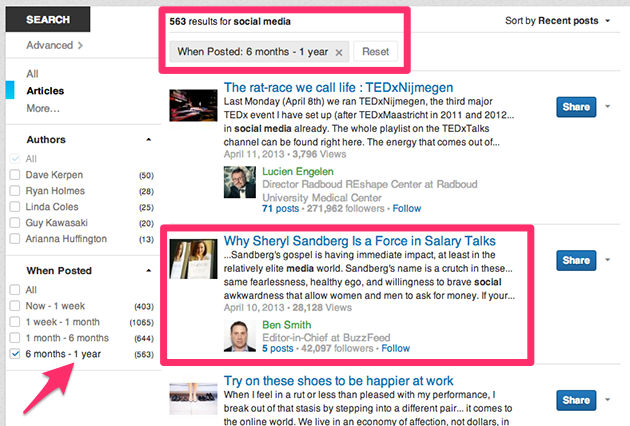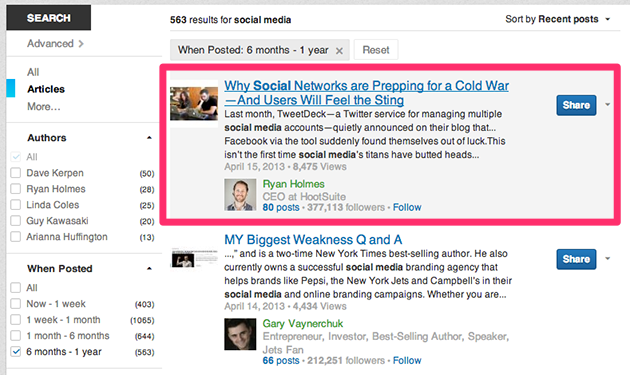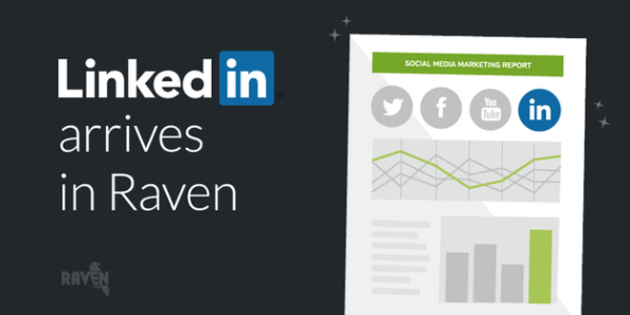You may have heard that LinkedIn is the next big thing for B2B marketing.
Pinterest is where the consumers are and LinkedIn is where the businesses are.
OK, maybe.
But you shouldn’t underestimate LinkedIn’s value for all marketers, especially when it comes to organic marketing.
Whether you’re an SEO, a content marketer, a social media marketer or a business owner of any stripe, LinkedIn is a great place to discover and be discovered. Even better, you don’t have to pay a dime to advertise or upgrade from a free account to do so.
Here are three ways you can stretch your marketing organically with LinkedIn:
1. Find link opportunities.
LinkedIn is transforming itself from a resume/CV warehouse to a publishing platform.
Only 25,000 people out of 277 million users have the privilege of writing articles for LinkedIn now, before the gates open to everyone. That means existing articles that mention your brand — or your competitors — were written by truly influential people.
Do you know whether any articles mention your brand? Are you making the most of them?
Start by searching articles for brand and competitor keywords.
First, check the authors. Are you connected? Do they like your Company page or Group? If not, you can send each a quick message to connect and thank them for the article where they mentioned you. Be sure to add each specific contact to Raven’s CRM, where you can assign tasks for more followup.
Next, check the sources. Who’s writing about your competitors or industry but not writing about you? Do you have something to offer that would be valuable to that publication’s audience? If so, you have an opportunity. Add the article to Raven’s Link Manager and queue it for outreach later.
Remember, you can comment on LinkedIn articles and share them, plus tag companies and authors. Do that to get noticed, just as you would for any blog commenting strategy.
Pro tip
LinkedIn search isn’t very smart, and it doesn’t support Boolean operators like AND, OR, quote marks or asterisks. For example, I had to search Majestic SEO (space) and MajesticSEO (no space) to find all references to the link data company in articles. Try all variations of your brand name to get the most results.
2. Revive interest in your brand.
Have the posts on your Facebook Pages started tanking in the News Feed? Many social media marketers have experienced this over the past few months, especially for image-only posts. That’s unfortunate for Facebook Page managers who don’t want to buy ads, because photos used to be among the highest drivers of engagement.
So take that engagement to LinkedIn, where you have a pretty good shot of being seen by your audiences without buying an ad (at least for now). Post photos of your company’s products or people as updates. At Raven, we found that our audience especially enjoys “sneak peeks” of new products and behind-the-scenes photos of our team members at work or play.
Tag your employees so that viewers can see their profile or ask to connect to them with one click. This is especially useful for your sales or customer-facing employees, where having lots of personal connections on LinkedIn could help them grow your business.
Include links back to your website — not just your LinkedIn company page — to encourage the engagement to follow through there. Then, use Raven’s Google Analytics integration to report the effect of your LinkedIn marketing on your company’s business goals.
Pro tip
Make your photos as large as possible to draw the most eyeballs. In LinkedIn’s Updates feed, photos display at up to 350 pixels wide and up to 265 pixels deep. Use that to your advantage when you’re posting articles. Consider posting just the image, then linking to your article in a comment. Viewers will see a larger image in their Updates list.
It’s the difference between this size…
and this size…
…in terms of impact. People scan, so grab attention any way you can.
3. Get instant ideas for updated content.
A great source of inspiration can be your own archives. If you made a promise or prediction — or described “the current state of affairs” at any time in the past — then you can update that specific article or write a new one with updated information. Viola! Fresh material for your audience.
You can do the same thing with anyone’s articles, really. And LinkedIn is a great way to see what the influencers were writing a year ago, back when only 150 “influential thought leaders” were allowed to write for the network. Then you can write an update for your own website — to be shared later on LinkedIn; see how this works full circle? — piggybacking off of the expert status and good reputation of the original author.
Here’s how:
- Search Articles for industry keywords.
- Sort by date.
- Filter to the oldest results to find the earliest articles.
- Find a specific story you want to update.
For example, in early 2013, it was hard to escape news and articles that featured businesswoman Sheryl Sandberg, who wrote Lean In: Women, Work and the Will to Lead. But now? How would you update a post like this one by the Editor-in-Chief at BuzzFeed?
For example, did women (and men) continue to invoke Sheryl Sandberg’s name during salary discussions after her book tour ended? I don’t know, but I’d love to find out from an HR professional.
Or consider this article. In April 2013, the CEO of HootSuite predicted a social media Cold War that would affect users.
Did that happen? Either way, what does your audience need to know now? Write and publish an update yourself.
Pro tip
In advance, share the article(s) on LinkedIn that you plan to update and ask for feedback. You’ll get material and sources for the updated article now, and you’ll have a built-in invested audience later.
How Raven can help
No matter what your LinkedIn organic marketing strategy is, you can use Raven to manage campaigns and report results to your managers and clients. Have you set up LinkedIn in Raven yet? Have you run a report? If not, authorize your profile, company or group in Raven now.

Analyze over 20 different technical SEO issues and create to-do lists for your team while sending error reports to your client.




